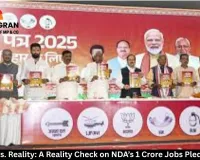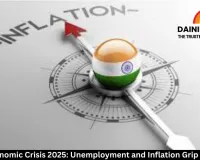Cloud Seeding in Delhi: A Costly Quick Fix That Misses the Mark on Air Pollution
Digital Desk

Is cloud seeding the answer to Delhi's deadly air pollution? Explore why artificial rain is a costly, temporary fix and why long-term solutions like stricter emission norms, electric vehicles, and curbing stubble burning are the real keys to clean air.
Delhi’s toxic winter air is back in the headlines, and with it, the familiar scramble for solutions. This time, the Delhi government experimented with artificial rain through cloud seeding—a technological intervention that promised to wash away the deadly particulate matter choking the city.
But as the haze refuses to lift, it’s clear that this approach is little more than an expensive, temporary distraction from the real, unresolved issues at the core of Delhi’s pollution crisis.
For years, we’ve known the primary culprits: vehicle emissions, industrial pollution, and stubble burning from neighboring states. Yet, rather than strengthening long-term systemic measures, authorities are leaning towards flashy, quick-fix solutions like cloud seeding.
The science is simple: chemicals like silver iodide are sprayed into existing clouds to induce rainfall, which then brings down pollutants like PM2.5 and PM10. However, the execution in Delhi’s dry winter atmosphere—where humidity is minimal and cloud cover is scarce—was doomed from the start.
Each cloud seeding trial costs approximately ₹64 lakh, a staggering sum for results experts call "negligible." Even if successful, the clean air lasts merely a few hours before pollution levels rebound. Why? Because the sources vehicles on the road, industries emitting smoke, and farmers burning crop residue continue unchecked. When you ignore the root causes, no amount of artificial rain can offer more than a fleeting respite.
What’s more, cloud seeding isn’t without ecological risks. The chemicals used can contaminate soil and water, posing threats to agriculture and aquatic life. And let’s not forget the unpredictability: without adequate cloud moisture, the technique fails, and in worst-case scenarios, it could even lead to urban flooding.
It’s time to ask: why are we investing crores in unproven, short-lived techno-fixes when sustainable solutions are staring us in the face? Effective measures include stricter implementation of the Bharat Stage VI vehicle emission norms, boosting electric vehicle infrastructure, regulating industrial emissions, and most critically addressing stubble burning through farmer-friendly policies and economic incentives.
The government must also prioritize improving public transport, enforcing dust control at construction sites, and fostering multi-state coordination under initiatives like the National Clean Air Program. Community awareness and participation are equally vital. Without public cooperation and a shift in policy focus from temporary relief to lasting change, Delhi’s pollution problem will continue to loom large, season after season.
Artificial rain might make for impressive headlines, but it’s no substitute for accountable, science-based and sustainable action. The people of Delhi and our environment deserve better.





.jpg)

.jpg)

.jpg)
